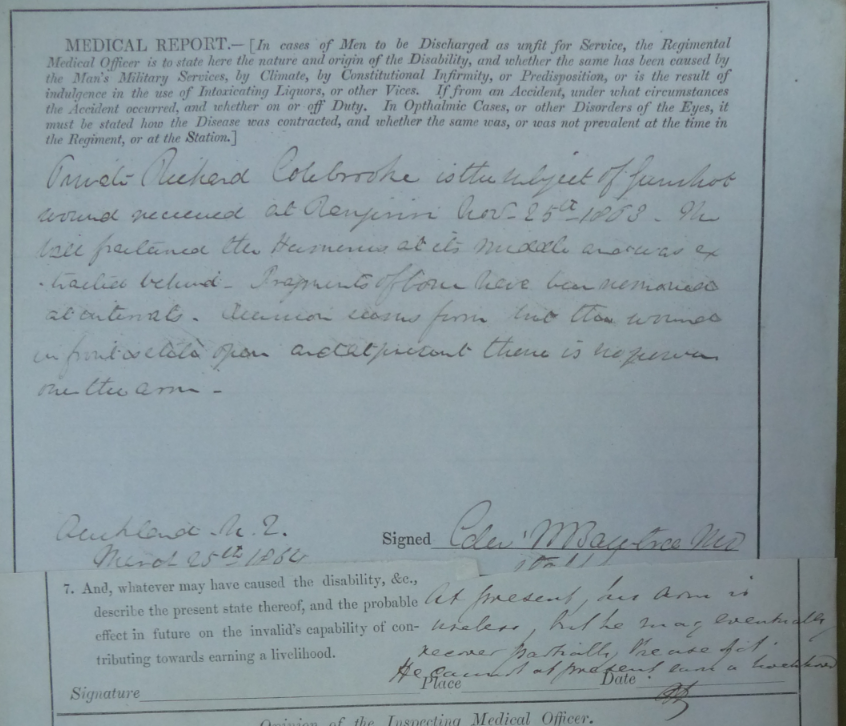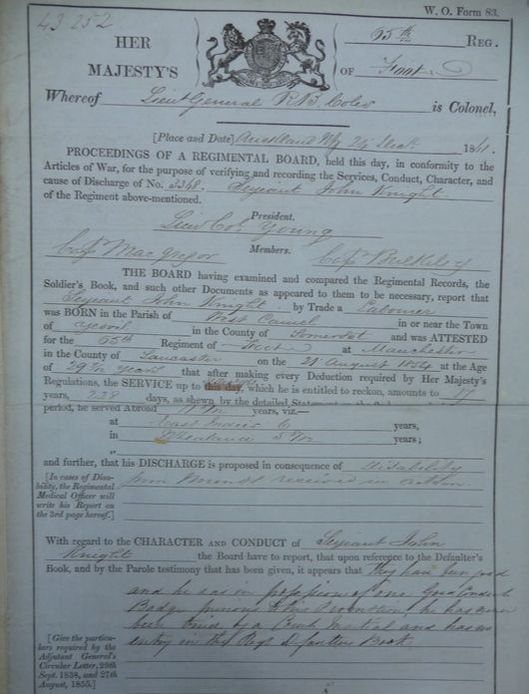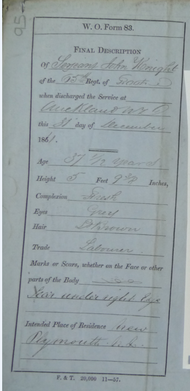|
Post by Summer Scholar Max Nichol Over the 2016/17 summer, I have been digging into a sample of documents from War Office files held in The National Archives in London. The documents come from the WO 97 series, which holds the products of an extraordinary exercise in bureaucracy. The series contains the discharge documents of thousands of imperial soldiers who served in Her Majesty’s army during the nineteenth century. The documents were created at the time soldiers applied to leave their regiment, as it was necessary for them to gain authority to be ‘discharged’ from their oath of service. The sample I have analysed contains 118 of those documents, all relating to soldiers who served in the New Zealand Wars in the 1860s. Specifically, this sample is drawn from the 50th and 65th Regiments of Foot, and the 68th Light Infantry. These documents contain a concise overview of a soldier’s time in the army: where they were born, where they enlisted, where they served, whether they were reprimanded (and for what), their reason for being discharged from service, and more. Some of the richest, most interesting information is contained in the reports completed by military surgeons as part of the application for discharge. Inspections were necessary for those men applying to leave the army on the basis of being found ‘medically unfit for further duty’. Not all soldiers had such an examination performed – for just under half of the sample who were discharged after completing their term of service (usually twenty-one years among this sample) this document is left blank. For the rest of the sample, these medical records offer a fascinating insight into the misfortunes which befell soldiers serving the British Empire. What stood out to me as I looked at these reports seems obvious with hindsight – the life of a soldier presented so many more opportunities for bodily harm than simply injury in battle. Certainly, injuries sustained in battle account for a reasonably high number of injuries resulting in discharge. To name just a few, Richard Colebrook and Francis Horne, both of the 65th Regiment, received wounds at the battle of Rangiriri in 1863, and John Moffet of the 68th Regiment took a musket ball in his right leg at Gate Pa Pukehinahina in 1864. However, the battlefield was far from the only places where soldiers sustained injury. The case of John Smith is particularly intriguing. He received a bullet through his left buttock in September 1864, leaving him permanently lame in that leg. However, the wound was not inflicted on the battlefield, nor even by the enemy. While transporting provisions to Te Awamutu, the wound was inflicted by ‘a comrade with homicidal intent’ – one of John’s own cohort. Frustratingly, the report does not elaborate beyond this. Who took a shot at poor John Smith, and why? Revenge for a long-standing grudge, or for some perceived slight perhaps? Or maybe tensions flared in the dangerous and uneasy environment of the Waikato in 1864. I like to think that somewhere deep in the stacks of the National Archives in London exists an accompanying document which tells the other side of this story. In its absence, we are left to imagine. The effects of disease also contributed heavily to the discharge of soldiers. The British Army did not suffer so many casualties to disease in New Zealand as in other colonies, like India, where diseases such as malaria, cholera, and dysentery wreaked havoc on European troop numbers. Nevertheless, many soldiers in the sample suffered from respiratory diseases such as bronchitis and tuberculosis, often attributed to exposure to the elements and the New Zealand climate. Some soldiers contracted illness elsewhere, and continued to be plagued by its effects during service in New Zealand. John Wilson and William Hyde were both discharged for chronic dysentery in New Zealand, but had contracted the disease while on service in the ‘East Indies’ (Rangoon) and India respectively. In this way, the effects of a soldier’s route through the Empire could have ongoing effects on his health for the rest of his service, and indeed his life. In some cases, the reason for discharge was not a specific incident or illness, but rather the cumulative effects of performing the duty of a soldier. In many cases, this manifested as chronic rheumatism. John Collins for example served for almost twenty-two years, and was discharged in 1861 with rheumatism and palsy of the hand. Charles Gallagher discharged with rheumatism in 1867 after twenty-two years of service. His medical report describes him as an “Old worn out man”. Alexander Crow also served for twenty-two years and was discharged in 1866 with chronic rheumatism attributed to “long service in New Zealand”. These men managed to avoid any significant injury or illness during their lengthy periods of service. Nevertheless, marching through rugged terrain with packs over their backs and rifles over their shoulders for over two decades clearly took its toll on their health. The imperial soldier’s purpose was ultimately to be engaged in battle in order to secure the sovereignty of the British Empire. However, it is worth considering that active participation in battle comprised only a fraction of the experience of an imperial soldier. The WO 97 files are once removed from the individuals that they catalogue – they exist as an attempt by the bureaucracy of the British Army to keep track of its soldiers for its own pragmatic purposes. Despite that abstraction, these records enrich our understanding of the lives of imperial soldiers in New Zealand with personal information and experiences which might otherwise be obscured or omitted from the historical record. As well as looking at the outcomes of certain battles and the movement of troops through New Zealand, we can consider the outcomes of actual soldiers who served in those battles and made those journeys while acting as agents of the British Empire. Images from the first and last forms in Sergeant John Knight's WO 97 file. WO 97/1587, TNA
15 Comments
10/11/2017 07:49:42 am
My great-grandfather was in the 43rd Regiment (Monmouth), taking his discharge in New Plymouth 1866 so no doubt such a file on him exists. Can you please tell me the process of accessing this file?
Reply
Rebecca Lenihan
10/11/2017 09:46:55 am
Hi Berris,
Reply
Vern Lack
19/7/2020 05:52:17 pm
Are there any records of the names of the soldiers of the 65th regiment of foot who sailed on the True Briton in Aug 1852 along with the names of their family members? In particular I'm chasing this for Private James Brooks.
Reply
14/7/2021 03:25:36 pm
I too am chasing records of members of the 65th that sailed on the "True Briton" - looking for William Brooks.
Reply
Koria
4/8/2021 10:11:35 am
I am chasing Pvte William Brooks reg. No. 2849 sailed to NZ on the True Briton arr. Dec 1852. I will keep an eye out for James. I remember seeing a James Brooks so will go back and see if I can locate him again. cheers Koria Davidson
Reply
Vernon Lack
4/8/2021 07:05:03 pm
I've just realised the ancestor I'm chasing was Thomas Brooks Rgt. # 2824. not James. My typo. I assume because he brought family with him to NZ and he had children whilst in service the military kept records of the family. But it appears no records have been kept or are available.
Koria Davidson
6/8/2021 03:17:21 pm
https://nla.gov.au/nla.obj-1650833535/view
Reply
Vern Lack
8/8/2021 06:15:00 pm
Thanks for the link, I've sifted through the Musters and noticed a George Brooks who was around before the others. was he a relo as well? Who do you have as parents? Due to a transcript error Thomas's parents were shown as Dan Brooks and Cath Daly but a check of the Baptism Record reveals it was Timorhy Brooks not Thomas.
Koria Davidson
9/8/2021 02:17:26 pm
Hello again,
Reply
Vern Lack
10/8/2021 07:06:12 pm
Hi Koria
Reply
Koria Davidson
10/8/2021 07:46:44 pm
Thank you Vern. Yes I am aware of the Trinity Church in Cambridge. Thank you for sending me the link.
Reply
Vern Lack
12/8/2021 06:33:19 pm
Sorry to bother you, where did you find enlistment records? Trying to sort ones way through The National Archives and Trove is proving to be anightmare.
Reply
Koria Davidson
12/8/2021 09:40:59 pm
Reply
Vern
13/8/2021 07:38:45 pm
Thanks Koria. You taught me how to use the files. But to no avail. Unlike William's discharge, Thomas's country of birth was not entered.
Reply
Leave a Reply. |
Archives
April 2022
Categories
All
|
Favicon image: Thomas Matravers album, Sir George Grey Special Collections, 3-137-26d, Auckland Libraries




 RSS Feed
RSS Feed